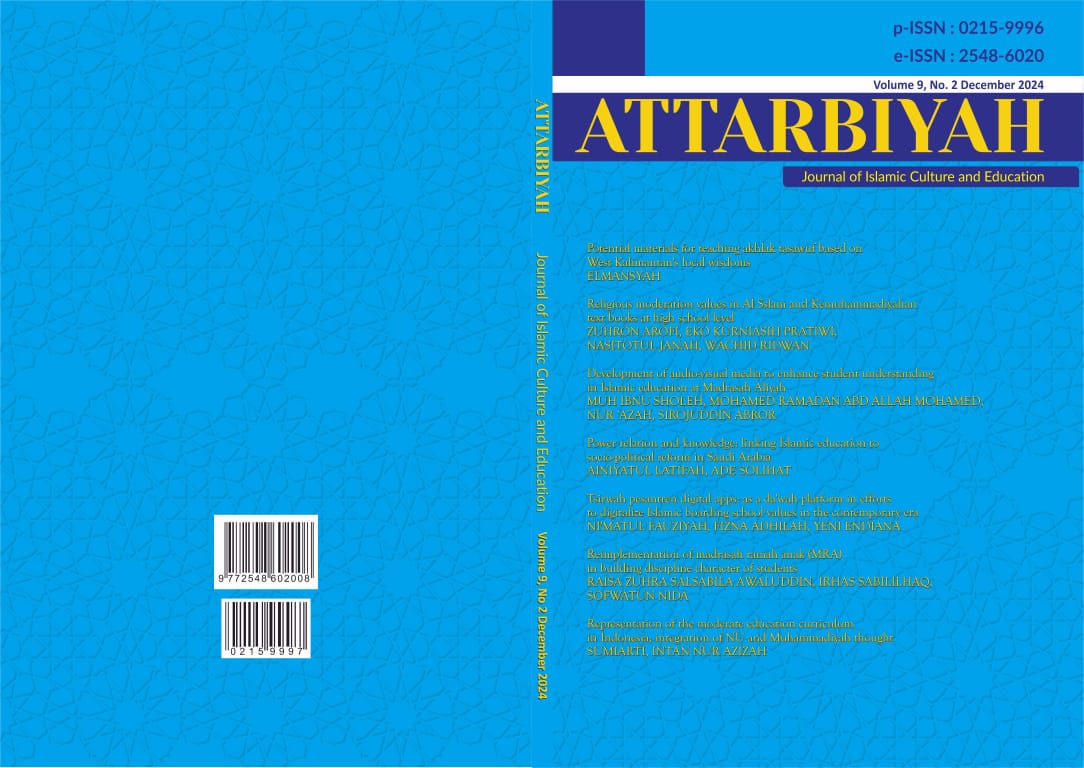Development of audio-visual media to enhance student comprehension in Islamic education
DOI:
https://doi.org/10.18326/attarbiyah.v9i2.145-156Keywords:
Educational Media, Audio-Visual, Student Understanding, Islamic EducationAbstract
This study aims to develop audio-visual media to enhance student understanding in Islamic Education at Madrasah Aliyah Tulungagung. A qualitative approach with a case study design was employed to explore in-depth the processes and experiences associated with the use of this media. The research subjects included Islamic Education teachers, students, the headmaster, and curriculum staff. Data were collected through in-depth interviews, focus group discussions (FGD), participant observations, and documentation. Data analysis involved transcription, coding, categorization, and interpretation. The findings indicate that audiovisual media are effective in assisting students in understanding complex and abstract concepts in Islamic education. This media also boosts student motivation and engagement in learning. However, the use of this media faces challenges such as limited technological facilities and preparation time constraints. The study recommends enhancing support for facilities and providing training for teachers to optimize the use of audio-visual media. With appropriate support, this media has the potential to become an effective tool in improving the quality of Islamic education at Madrasah Aliyah Tulungagung and other madrasahs in Indonesia.
References
Aini, U. N., Utami, T. W., Khalidiyah, T., & Huriyah, L. (2022). Pemanfaatan Media Pembelajaran Berbasis Video Menggunakan Aplikasi Benime dalam Meningkatkan Pemahaman pada Mata Pelajaran Pendidikan Agama Islam dan Budi Pekerti (PAIBP)
Siswa SMP. Edudeena : Journal of Islamic Religious Education, 6(1), 57–65. https://doi.org/10.30762/ed.v6i1.117.
Ajit, G., Lucas, T., & Kanyan, R. (2022). Design and Technology in Malaysian Secondary Schools: A Perspective on Challenges. Malaysian Journal of Social Sciences and Humanities (MJSSH), 7(1), 335–351. https://doi.org/10.47405/mjssh.v7i1.1219.
Amri, M., Saharuddin, S., & Ahmad, L. O. I. (2019). The Implementation of Islamic Education: The Process of Instilling Akhlakul Karimah (Noble Characters) for Madrasah Tsanawiyah Students. Tadris: Jurnal Keguruan Dan Ilmu Tarbiyah, 4(1), 117–125. https://doi.org/10.24042/tadris.v4i1.4070.
Bebell, D., & O'Dwyer, L. (2010). Educational Outcomes and Research from 1:1 Computing Settings. The Journal of Technology, Learning and Assessment, 9(1).
Betrancourt, M. (2005). The Animation and Interactivity Principles in Multimedia Learning. He Cambridge Handbook of Multimedia Learning, 5(6).
Chartofili, A., & Fokides, E. (2019). Teaching Local History, Culture, Traditions, and Customs Using Digital Games: Preliminary Results from a Case Study in the Island of Nisyros. Open Journal for Educational Research, 3(2), 81–94. https://doi.org/10.32591/coas.ojer.0302.04081c.
Clark, R. C., Mayer, R. E., & Thalheimer, W. (2003). E-learning and the science of instruction: Proven guidelines for consumers and designers of multimedia learning. Performance Improvement, 42(5), 41–43. https://doi.org/10.1002/pfi.4930420510.
Creswell, J. W. (2009). Research design: Qualitative, quantitative, and mixed methods approaches (3rd ed). Sage Publications.
Ertmer, P. A., & Ottenbreit-Leftwich, A. T. (2010). Teacher Technology Change: How Knowledge, Confidence, Beliefs, and Culture Intersect. Journal of Research on Technology in Education, 42(3), 255–284.https://doi.org/10.1080/15391523.2010.10782551.
Fink, A. (2019). Conducting research literature reviews: From the internet to paper. Sage publications.
Gliner, J. A., & Morgan, G. A. (2017). Research Methods in Applied Settings: An integrated approach to design and analysis.
Hasan, S., & Hidayati, L. (2023). Nilai Pendidikan Akhlak dalam Film Animasi Nussa dan Rara sebagai Media Pembelajaran Materi Akidah Akhlak di MI Nurul Huda Srimulyo. UPIN (Jurnal Pendidikan Islam Nusantara), 02(1).
Hasanah, N. Z., Sutra, S. D., Istiqomah, I., Dewantara, M. H., & Boulahnane, S. (2022). The Role of Islamic Education in Teaching Moral Values to Students. MUDARRISA: Jurnal Kajian Pendidikan Islam, 14(1), 33–47. https://doi.org/10.18326/mdr.v14i1.33-47.
Kotiash, I., Shevchuk, I., Borysonok, M., Matviienko, I., Popov, M., Terekhov, V., & Kuchai, O. (2022). Possibilities of Using Multimedia Technologies in Education. International Journal of Computer Science and Network Security, 22(6), 727–732. https://doi.org/10.22937/IJCSNS.2022.22.6.91.
Maskun, M., Sumargono, S., Pratama, R. A., & Maydiantoro, A. (2021). The Effectiveness of Historical Documentary Films as Information Technology in Improving Student Learning Outcomes. International Journal of Education and Information Technologies, 15, 183–190. https://doi.org/10.46300/9109.2021.15.19.
Mayer, R. E. (2014). Multimedia Instruction. In J. M. Spector, M. D. Merrill, J. Elen, & M. J. Bishop (Eds.), Handbook of Research on Educational Communications and Technology (pp. 385–399). Springer New York. https://doi.org/10.1007/978-1-4614-3185-5_31.
Mertens, D. M. (2023). Research and evaluation in education and psychology: Integrating diversity with quantitative, qualitative, and mixed methods. Sage publications.
Rogers, Y. (2012). HCI theory: Classical, modern, and contemporary (1–14). Morgan & Claypool Publishers.
Sanusi, I., Sholeh, M. I., & Samsudi, W. (2024). The Effect Of Using Robotics In Stem Learning On Student Learning Achievement At The Senior High School. Educational Administration: Theory and Practice, 30(4), 3257–3265.
Sholeh, M. I. (2023a). Evaluation and Monitoring of Islamic Education Learning Management in Efforts to Improve Education Quality. Communautaire: Journal of Community Service, 2(2), 108–117. https://doi.org/10.61987/communautaire.v2i2.159.
Sholeh, M. I. (2023b). Strategi Manajemen Organisasi Pendidikan Islam dalam Menghadapi Tantangan Global. Edu Journal Innovation in Learning and Education, 1(1), 1–27. https://doi.org/10.55352/edu.v1i1.456.
Sholeh, M. I., Nasihudin, M., Ahmad, Z., & Azizah, M. (2024). Mengoptimalkan Penggunaan Teknologi Untuk Pemasaran Aksesoris Hp Anggota Onc Melalui Platform Digital. 2(1).
Shull, F., Singer, J., & Sjøberg, D. I. K. (Eds.). (2008). Qualitative Methods in Empirical Studies of Software Engineering. Springer.
Sorden, S. D. (2012). The Cognitive Theory of Multimedia Learning. Handbook of Educational Theories, 1, 1–12.
Susan L. Douglass & Munir Shaikh. (2004). Defining Islamic Education: Differentiation and Applications. Current Issues in Comparative Education, 7(1).https://doi.org/10.52214/cice.v7i1.11386.
Sweller, J., Ayres, P., & Kalyuga, S. (2011). Cognitive Load Theory. Springer New York. https://doi.org/10.1007/978-1-4419-8126-4.
Wang, F., & Hannafin, M. J. (2005). Design-Based Research and Technology-Enhanced Learning Environments. Educational Technology Research and Development, 53(4), 5–23.
Wang F., Xie H., & Li H. (2016). Visual text or narration? Meta-analysis of the modality effect in multimedia learning. Advances in Psychological Science, 24(3), 335. https://doi.org/10.3724/SP.J.1042.2016.00335.
Xu, L., Aranda, G., Widjaja, W., & Clarke, D. (Eds.). (2019). Video-based research in education: Cross-disciplinary perspectives. Routledge, Taylor and Francis Group.
Yildirim, S. (2018). The Effect of Educational Videos Used in History Education on Academic Success. Journal of Education and E-Learning Research, 5(3), 193–207. https://doi.org/10.20448/journal.509.2018.53.193.207.
Downloads
Published
How to Cite
Issue
Section
License
Copyright (c) 2024 Muh Ibnu Sholeh, Mohamed Ramadan Abd Allah Mohamed, Sokip, Nur 'Azah, Sirojuddin Abror

This work is licensed under a Creative Commons Attribution-ShareAlike 4.0 International License.







